Exobiotica - Exobiotica

More Posts from Exobiotica and Others

Part of a color study for the next painting I plan to start this week.






Monolith
The seasonal rains have come to the high desert. Among the first to respond is the monolith. It sends out hose-like tendrils to siphon water and turns on its biolights to attract flying symbionts.






World Eater
In the murky ponds on the floor of the Glow Forest lives a surprisingly diverse community adapted to the near total darkness. Decaying organic material releases methane gas which is harnessed by towers of colonial microorganisms. Upon this bedrock of the food chain, a plethora of creatures creep and crawl about their daily lives while trying to avoid the pond’s top predator - a massive leviathan blindly devouring everything in its path.
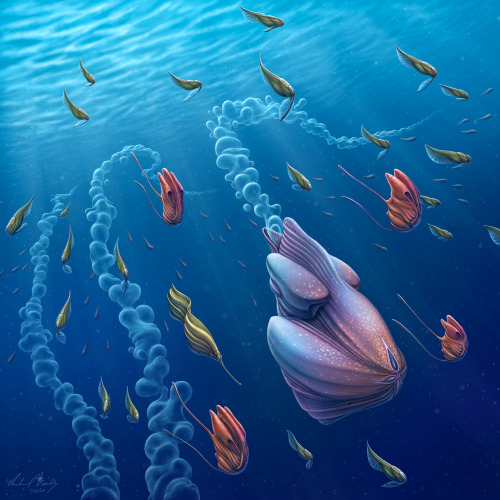
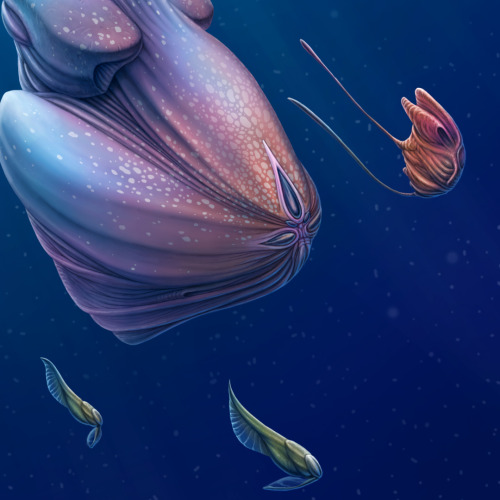
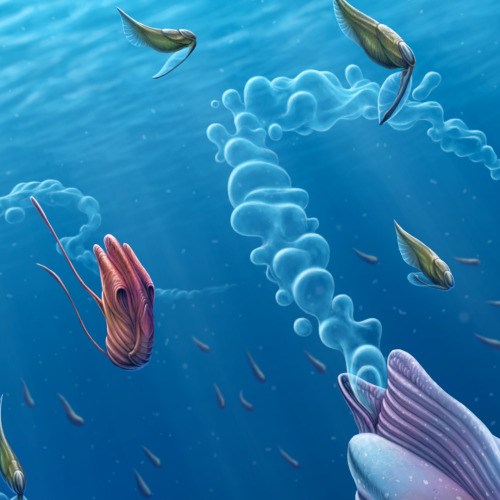
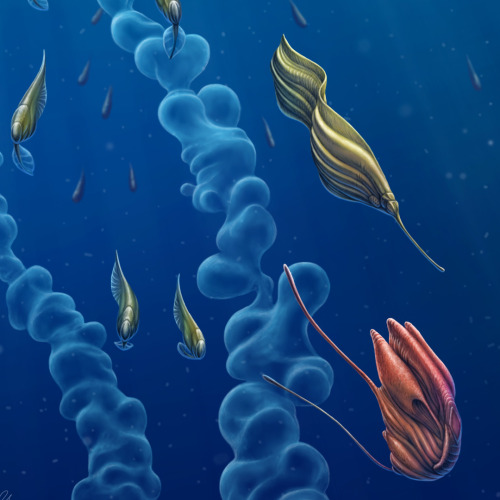
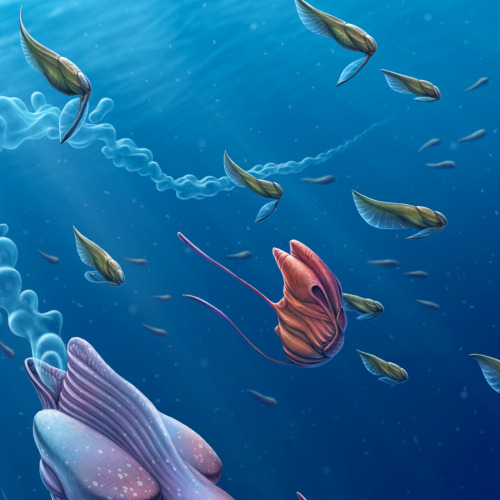
Back to the Depths
An entourage of opportunistic creatures accompanies the deep-sea behemoths during their brief ascent to the surface. Releasing their gelatinous strings of embryos here in the sunlight has a significant benefit - there's far more visibility. The swarm of followers are here in search of a quick meal in the form of the gelatin, which is full of valuable protiens and nutrients. After the feast however, the recipients of this apparent windfall become unwitting hosts for the behemoth's multitudinous offspring, which were embedded in the gel. Adapted to develop inside a wide variety of pelagic creatures, the young grow internally - and sometimes even on the surface of - their hosts until such time as they detach and sink back into the darkness. For most host species, this seems to be a mutually-beneficial symbiosis. At the beginning they receive a large and valuable meal, and usually incur very little detriment due to their temporary parasites. The young behemoths will hide in the dark depths for many years until attaining the size necessary to return to the light and repeat the ancient cycle again.

A common site in these dry rocky areas is the Velumignus. Their immobile bases send tendrils deep underground in search of water, while the photosynthetic flattened upper portions can swivel to accommodate for light and wind direction. Reaching a height of over fifteen feet, these silent sun-catchers often serve as way-finding posts to creatures journeying through the High Desert.






Codependence
Natural selection breeds competition, but it can also lead to sophisticated cooperation. The Glass Colligatio is what is known as a composite organism—a creature comprised of members of multiple species that share critical biological processes between them. The larger swimmer provides mobility, while its multi-legged symbiont feeds more efficiently than it could alone. Through the interspecies junction—a specialized dual orifice connecting the creatures—they share nutrients and oxygen, each specializing in what it does best while providing for the needs of the whole.

Luminous Oppugno
Submarinus luminare
Named for the Latin word for 'attack', the Luminous Oppugno is a crafty aquatic predator. Primarily nocturnal, it uses its bioluminescent-tipped rods to attract prey. Once within range, the main grasping appendage shoots out and arrests the unsuspecting victim with vigorous tenacity. Being fully aquatic (dwelling rather deeply at that) as well as nocturnal, the oppugno rarely comes into contact with sunlight, and thus has lost the capability of its ancestors to harness energy from photons. Thus, the creature must rely exclusively on its skill as a predator to meet its energy requirements. An adult oppugno usually tops out at around 5 feet long.





Full of Stars
The season's storms had taken their toll, opening up an organic cave in the otherwise sealed mountain canopy forest. Encouraged by the prospect of shelter from more incoming inclement weather, the dacia considers entering the dark, yet inviting refuge. The glittering biolights beckon, but this new environment is far stranger than anything it’s ever known.

Sky Shepherds
Caelumopilio pictoratus
This work serves as the official kickoff for my illustration project called "Exobiotica". The creature pictured is a Sky Shepherd. As its name implies, it carries on an aerial existence - maintaining neutral buoyancy via internal hydrogen compartments. The front appendages serve two functions- they are used to physically herd or corral the species of floating creature they subsist on, and also they are equipped with color-changing tissue that is used as communication between members of their group. Like them, most of their predators and prey are essentially floating gas bags which are highly susceptible to rupture. Thus, the Sky Shepherd evolved sharp appendages for use in attack and defense. Propulsion in any direction is achieved by the intake of air at the ventral posterior end, and then subsequent directional exhalation of the air through any of the four siphons. The next work will I produce will feature these creatures and their prey in their aerial environment.
-
 equibo liked this · 1 year ago
equibo liked this · 1 year ago -
 magnificentsweetsdaze reblogged this · 1 year ago
magnificentsweetsdaze reblogged this · 1 year ago -
 magnificentsweetsdaze liked this · 1 year ago
magnificentsweetsdaze liked this · 1 year ago -
 wtrotsky-blog liked this · 1 year ago
wtrotsky-blog liked this · 1 year ago -
 spiffyspidr liked this · 2 years ago
spiffyspidr liked this · 2 years ago -
 walkingmybird liked this · 2 years ago
walkingmybird liked this · 2 years ago -
 litchkiing liked this · 2 years ago
litchkiing liked this · 2 years ago -
 shitou456 liked this · 3 years ago
shitou456 liked this · 3 years ago -
 crusty liked this · 3 years ago
crusty liked this · 3 years ago -
 omegaxenonaut liked this · 3 years ago
omegaxenonaut liked this · 3 years ago -
 aphid-kirby liked this · 3 years ago
aphid-kirby liked this · 3 years ago -
 squirrel-stars liked this · 3 years ago
squirrel-stars liked this · 3 years ago -
 ferncube liked this · 3 years ago
ferncube liked this · 3 years ago -
 astrotracksuitbattalion liked this · 4 years ago
astrotracksuitbattalion liked this · 4 years ago -
 theimmortalcorpse reblogged this · 4 years ago
theimmortalcorpse reblogged this · 4 years ago -
 theimmortalcorpse liked this · 4 years ago
theimmortalcorpse liked this · 4 years ago -
 absul liked this · 4 years ago
absul liked this · 4 years ago -
 the-chickadeity liked this · 4 years ago
the-chickadeity liked this · 4 years ago -
 klumquat liked this · 4 years ago
klumquat liked this · 4 years ago -
 reibi liked this · 4 years ago
reibi liked this · 4 years ago -
 staurozoaaa liked this · 4 years ago
staurozoaaa liked this · 4 years ago -
 deadgirlsareticklish reblogged this · 4 years ago
deadgirlsareticklish reblogged this · 4 years ago -
 deadgirlsareticklish liked this · 4 years ago
deadgirlsareticklish liked this · 4 years ago -
 karltface liked this · 4 years ago
karltface liked this · 4 years ago -
 woman-of-the-fen liked this · 4 years ago
woman-of-the-fen liked this · 4 years ago -
 bluejbullshit liked this · 4 years ago
bluejbullshit liked this · 4 years ago -
 theveryworstthing liked this · 4 years ago
theveryworstthing liked this · 4 years ago -
 unseelie-ghuleh liked this · 4 years ago
unseelie-ghuleh liked this · 4 years ago -
 of-him-the-harpers-sadly-sing liked this · 4 years ago
of-him-the-harpers-sadly-sing liked this · 4 years ago -
 gutslug liked this · 4 years ago
gutslug liked this · 4 years ago -
 suppuration liked this · 4 years ago
suppuration liked this · 4 years ago -
 animalcrossingnewhorizons reblogged this · 4 years ago
animalcrossingnewhorizons reblogged this · 4 years ago -
 animalcrossingnewhorizons liked this · 4 years ago
animalcrossingnewhorizons liked this · 4 years ago -
 izzychao liked this · 4 years ago
izzychao liked this · 4 years ago -
 captain-asparagus liked this · 4 years ago
captain-asparagus liked this · 4 years ago -
 bowelflies reblogged this · 4 years ago
bowelflies reblogged this · 4 years ago -
 captaincoombs liked this · 4 years ago
captaincoombs liked this · 4 years ago -
 salmonofwisdom liked this · 4 years ago
salmonofwisdom liked this · 4 years ago -
 penumbra51302 liked this · 4 years ago
penumbra51302 liked this · 4 years ago -
 squanderedpotentials liked this · 4 years ago
squanderedpotentials liked this · 4 years ago -
 metalzoic liked this · 4 years ago
metalzoic liked this · 4 years ago -
 natesart liked this · 5 years ago
natesart liked this · 5 years ago -
 death-s-head-hawkmoth liked this · 5 years ago
death-s-head-hawkmoth liked this · 5 years ago -
 vanjets reblogged this · 5 years ago
vanjets reblogged this · 5 years ago -
 vanjets liked this · 5 years ago
vanjets liked this · 5 years ago



